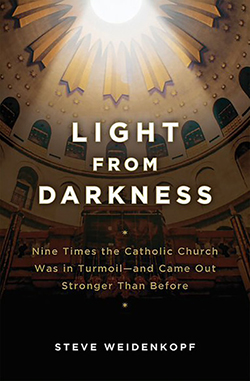Think the church is in turmoil? New book explores history and points to hope

Reviewed for The Catholic Post by Matthew Vander Vennet
As a church historian, whenever a new historical title becomes available, I get excited. “Light from Darkness: Nine Times the Catholic Church was in Turmoil — and Came Out Stronger than Before” by Steve Weidenkopf is the most recent work that caught my eye.
Weidenkopf is a church historian and has published many works on Catholic Church history. In addition, he is a church history professor at Christendom College, so he certainly knows about what he writes.
Published by Catholic Answers, “Light from Darkness” offers a historical perspective on how to view the current state of affairs in the church and the world. This is not the first time that the church or humanity has found itself at a crossroads. Indeed, this will not be the last time that the church or the world will face crises, both internal and external. These times are not the worst that the church has faced.
What Weidenkopf delivers is wisdom from the tradition and history as a model for us as we navigate these tumultuous times.
NO REASON FOR DESPAIR
A knowledge of church history offers modern man “the antidote to this tyranny of the present . . . and gives us a long-term perspective on God’s divine plan.” (19) There really should be no reason for despair and anxiety because during each previous crisis in the church, reform and renewal followed. Worthy men and women rose up in response to God’s call to cooperate in His divine plan for the church. Many of these men and women were declared saints in time.
Patience and God’s timing must always be sought in resolving any issues or crises that arise.
It is up to us in our present age, both laity and clergy, to continually look to the inspiration of the Holy Spirit in order to allow Him another chance to bring light from the darkness through us. Remember, the gates of hell shall not prevail against the church! (Mt 16:18)
Before reviewing the content, the design of the book is quite practical and helpful. One design aspect particularly beneficial is the timeline at the very beginning of each chapter which shows the duration of each crisis visually. In a shaded gray section in the beginning of each chapter, Weidenkopf also showcases succinctly both the darkness and the light which resulted. In addition, the writing is accessible without being overly academic (endnotes are included) and truly informative. Within each chapter, he offers the background to the issue, a section on the crisis itself, and the resulting renewal that was spawned.
NINE GREAT CRISES
Like all good history books, Weidenkopf starts at the very beginning and follows chronologically the great crises that befell the church throughout the ages. He has identified nine of them to focus upon.
In the first instance, for example, the issue at hand was the Lapsi — those who apostatized and subsequently sought reconciliation with the church — and what to do about them. Divergent views threatened the unity of the church. The wrangling went on for roughly 125 years (AD 200-325), a timeframe that we must consider when approaching the issues of our own day, until it was decided that the Lapsi would be shown mercy, directly contributing to the church’s understanding of penance and reconciliation. Patience and God’s timing must always be sought in resolving any issues or crises that arise.
Weidenkopf proceeds to address in ensuing chapters the church crises known as the “Puppet Papacy,” “Clerical Corruption and Sexual Immorality,” “The Investiture Controversy,” “The Albigensian Heresy,” “Avignon and the Great Western Schism,” “The Renaissance Papacy and the Great Revolt,” “The Enlightenment,” and finally, “Modernism and Neo-Paganism.” Every chapter is a compelling read and truly informative.
The final chapter is particularly germane for our times. It is not a stretch to consider that we are still actively engaged in the battle that commenced only at the beginning of the last century. The effects of the events of the 20th century and the early 21st century and the responses to them will be the study of future historians.
Finally, Weidenkopf gives a closing chapter on how not to respond to situations within the Church by juxtaposing Savonarola and St. Catherine of Siena. Both experienced upheavals and turmoil and recognized the need for reform and renewal in the Church. Only one has been declared a saint.
With Weidenkopf, I too, hope that our age will be another age of great saints from all corners and facets of the church, working with the Holy Spirit to bring true light to this present darkness. Perspective can often change attitudes and provide hope for many. “Light from Darkness” is a timely work in that respect. Anyone anxious about the times or with any interest in Church history will enjoy this book. Find it at your local Catholic bookstore or at catholic.com.
—
MATTHEW VANDER VENNET is director of advancement and development at The High School of Saint Thomas More in Champaign and a member of The Catholic Post’s book review team.






